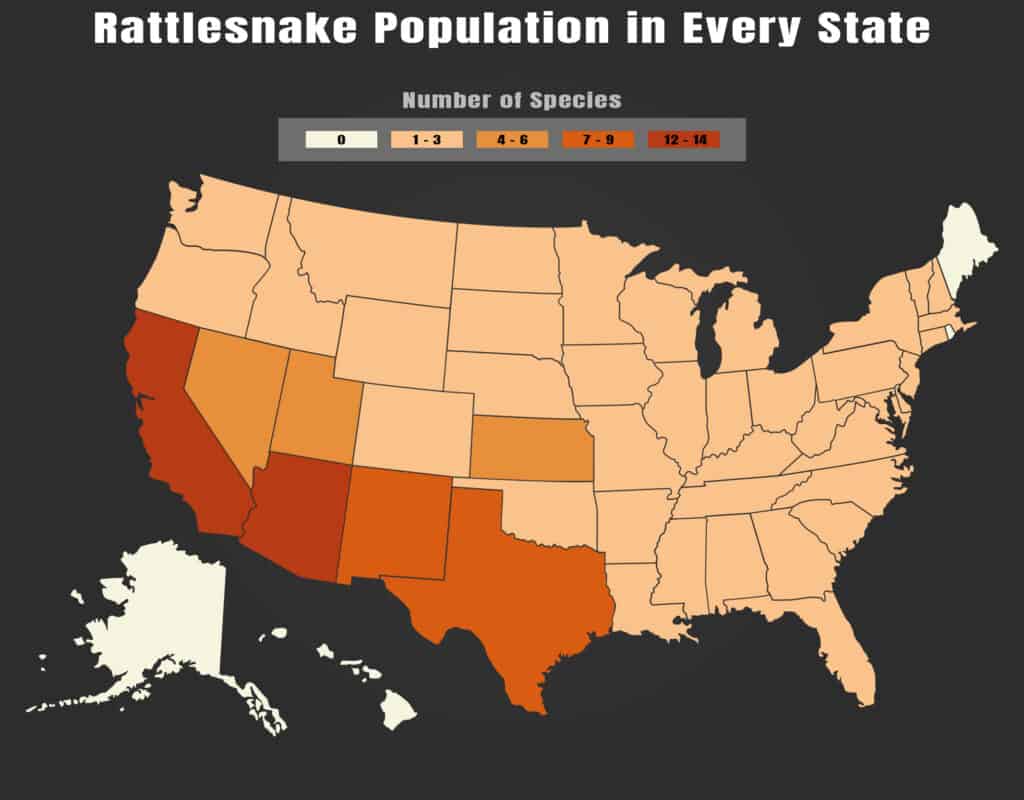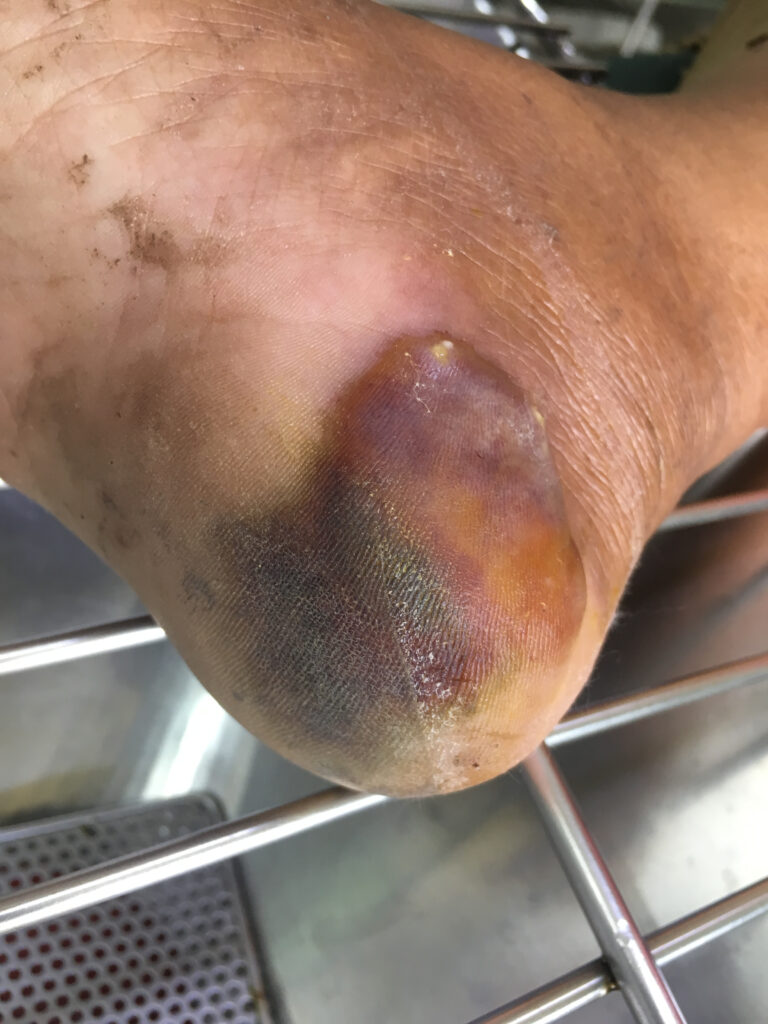We have bad news for you. If you live anywhere between southern Canada and Northern Argentina, you could be bitten by a rattlesnake. In the United States alone, up to 8,000 people a year get bitten by these pit vipers. These snakes don’t always rattle their tail before they strike, so you won’t always know they’re coming. And they can lunge 2/3 of their body length, meaning a 6-ft. long snake can strike someone 4 feet away. One species, the southwest’s Mohave rattlesnake, has one of the deadliest venoms of any snake species in the world. This venom is more toxic even than that of the king cobra or black mamba. So, do you know how to survive a rattlesnake attack?
Rattlesnake Bite Overview
Are you starting to wonder if it’s even possible to survive a rattlesnake attack? Well, it is. Because here’s the good news: the vast majority of people never run into a rattlesnake in the wild. About 8,000 people are bitten in the U.S. every year. A good percentage of these victims messed with the snake beforehand. They were trying to kill it, scare it off, or pick it up, instead of just leaving it alone. Rattlesnakes try to get away from people silently. If they can’t escape fast enough, they rattle, and then they strike as a last resort.
When they do bite, 60-80% of the time they do not inject venom. And of those thousands of people who do get bitten, less than a dozen die every year. Your chances of getting killed by falling down the stairs are exponentially higher, so be careful! But in the extremely unlikely event you are bitten, this article will tell you what you need to do. This way, you won’t end up among the unlucky few who don’t live to talk about it.


Rattlesnakes have retractable fangs that can deliver potent venom, but they can also bite without injecting venom.
©Maria Dryfhout/Shutterstock.com
Hey Rattlesnake, What’s Shaking?
The most distinctive thing about rattlesnakes, of course, is that rattling tail. They’re born venomous, but not born with rattles (kind of sad, actually, doesn’t a baby need a rattle?). They start off with a little button on the end of their tail and gain a new segment of a rattle each time they shed their skin. The rattle is made of keratin, incidentally, which is the same thing your fingernails are made of. In addition to their rattles, you can also identify rattlesnakes by their triangular-shaped heads. At full adulthood, rattlesnakes are usually from 3-6 feet long, although snakes as long as 8 feet have sometimes been reported. Their color patterns are in earth tones of brown, grey, and black, which helps them stay camouflaged.
Rattlesnakes prey on small mammals like rats, mice, prairie dogs, and rabbits, as well as birds and reptiles like turtles, frogs, lizards or even other snakes. They can detect the heat of their prey, and they’re perfectly designed to fit into their holes and burrows and chase them down. But strangely, in the winter rattlesnakes will sometimes share a burrow with snakes of their own or other species, with lizards, or turtles. It’s a win-win, as they can help each other stay warm. As reptiles, rattlesnakes regulate their body temperature by sunning themselves lying out on a warm rock or road.

Rattlesnakes add another segment to their rattles each time they shed their skin.
©Chase D’animulls/Shutterstock.com
How to Avoid a Rattlesnake Bite
The first way to avoid a rattlesnake bite is to avoid rattlesnakes. They are most active in the morning and the evening when the temperature is neither hot nor cold. And the times of the year they are most active are spring and fall. So at those times, you may want to be especially vigilant. You can also educate yourself about what species of venomous snakes live in your area, what they look like, and what their preferred habitat is.
Environment
Rattlesnakes thrive in a variety of environments, such as forests, grasslands, scrub brush, swamps, and deserts. And you might be surprised to know they can swim really well, so that stick you see floating in the lake while you’re fishing may not be a stick. Around your property, a rattlesnake might hide under piles of firewood, brush piles, in tall grass, under rock piles or shrubbery. They could also pursue prey or seek shelter from cold weather in storage buildings, barns, or cellars. So, keeping all those areas cleaned up is one way to keep rattlesnakes away from your property. Consider hiring professionals to do the cleanup if the job is big and your situation seems especially risky, such as if you have seen snakeskins lying around.
Factors to Be Aware of
When you go out, stay on marked trails, don’t walk around in the dark, or place your hands and feet someplace you can’t see. Wear long pants and sturdy, close-toed shoes. If you’re camping, shake out clothes, shoes, and sleeping bags before using them. If for some reason you need to move a rock or log, roll it toward you so that anything hiding under it can slither away in the opposite direction.
When you’re walking with your dogs, always keep them on a leash to prevent them from roaming through the brush and getting bitten. If you see or hear a live snake, immediately back away and go the opposite direction. Don’t try to kill it; call animal control specialists to take care of it for you. If you or your dogs find a rattlesnake that looks dead, don’t go near it. Even if the head is detached, it can still bite reflexively and inject venom.

To keep your dog on a leash when walking to prevent it from roaming into the tall grass and brush where it could be bitten by a rattlesnake.
©Christian Mueller/Shutterstock.com
What To Do If You Are Bitten
- Stay calm. An elevated heart rate will cause the venom to circulate more quickly.
- Call 911 or in a remote area, use a radio to call for help.
- Run soapy water over the bite.
- Take off anything that might constrict your blood flow as the affected limb swells such as bracelets or rings.
- Keep the bite below the level of your heart and keep the limb immobile to slow the venom’s spread.
- Do not apply a tourniquet, make incisions over the bite, or apply ice.
- Do not attempt to suck the venom out with your mouth or allow anyone else to. Venom can be swallowed or get into the bloodstream through cuts or sores.
- If you have a snakebite kit, it may have a suction device that can be used to draw venom out of the wound.
- If you have someone drive you to the emergency room, they should not drive at high speeds because this can increase the snakebite victim’s heart rate and risk an accident that would create worse problems and delay treatment for the bite longer.
- If the victim is a pet, get it to an emergency vet as soon as possible.

Although frightening, a rattlesnake bite is something victims usually completely recover from with proper medical treatment.
©Chuanpit/Shutterstock.com
No doubt about it, most people find rattlesnakes pretty scary, and that’s a good thing if it makes us treat them with a healthy respect and keep our distance. But the reality is that they are actually not that difficult to avoid if we learn a little about their behavior and take reasonable precautions. And in the case of a bite, you are overwhelmingly likely to recover if you stay calm and get immediate medical care.
The photo featured at the top of this post is © Joe McDonald/Shutterstock.com
Discover the "Monster" Snake 5X Bigger than an Anaconda
Every day A-Z Animals sends out some of the most incredible facts in the world from our free newsletter. Want to discover the 10 most beautiful snakes in the world, a "snake island" where you're never more than 3 feet from danger, or a "monster" snake 5X larger than an anaconda? Then sign up right now and you'll start receiving our daily newsletter absolutely free.
Thank you for reading! Have some feedback for us? Contact the AZ Animals editorial team.






